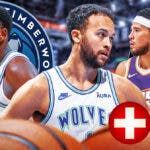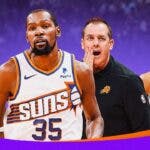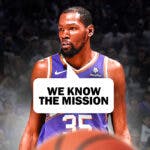Minnesota Timberwolves fans haven't had much to be excited about since their team entered the NBA in 1989. The team has only made the playoffs 11 times in 35 seasons and has only won two playoff series, both of which came in 2004 when they made the Western Conference Finals. Nonetheless, Timberwolves fans have something to be ecstatic about right now with the rise of Anthony Edwards as one of the brightest stars in the NBA, especially with what he is showing with Team USA. Heck, even the greatest Timberwolves player ever Kevin Garnett is liking what he is seeing from Antman.
Small-market franchises like the Timberwolves need the help of the draft as well as executing the right trades to achieve success in the NBA. Minnesota has made its fair share of deals that have either helped elevate the team or ended a dark period in its history. With that, let's check out some of the best trades in Minnesota Timberwolves history.
8. Trading for Tom Gugliotta
Timberwolves received: Tom Gugliotta
Timberwolves traded: Donyell Marshall
The Timberwolves acquired Tom Gugliotta from the Golden State Warriors midway through the 1994-95 season in exchange for Donyell Marshall. The man had his most productive seasons in Minnesota. Most die-hard Timberwolves fans remember him as the third piece as part of an emerging trio with the Timberwolves alongside Kevin Garnett and Stephon Marbury.
Gugliotta had the best year of his career in the 1996-97 season, where he earned the lone All-Star nod of his career. He averaged 20.6 points per game that season along with 8.7 rebounds, 4.1 assists, 1.6 steals, and 1.1 blocks. Those all-around numbers would be a dream among NBA fantasy managers. He helped the team reach the playoffs for the first time in 1997.
It's easy to forget Gugliotta within the basketball landscape because he was someone who played ahead of his time. For the newer generation of NBA fans, Gugliotta was a 6-foot-10 forward who had range and could step out beyond the arc at times. He also possessed a nice touch on his passes that was otherwise not seen among big men during his era. His playing style and skills would make him a quintessential big man in today's NBA.
7. Trading Stephon Marbury for Terrell Brandon and a future pick
Timberwolves received: Terrell Brandon, Brian Evans and a 1999 first round pick (which ended up becoming Wally Szczerbiak)
Timberwolves traded: Stephon Marbury, Bill Curley, Paul Grant, and Chris Carr
On surface, this may have looked like a bad deal for the Timberwolves because they traded the best player from this deal. Marbury was an emerging young star in the NBA, but he asked out because he wanted to move closer to his hometown of New York and didn't like the life he had in Minnesota.
Nonetheless, this trade actually helped them become a 50-win team in the 1999-00 season and stay a perennial playoff squad for the succeeding seasons. Minnesota still acquired a solid point guard in Terrell Brandon, who averaged over 17 points per game in his first year with the Timberwolves. But apart from Brandon, they also got the 6th overall pick in the 1999 NBA Draft, where they wound up taking Wally Szczerbiak.
Szczerbiak quickly emerged as one of the top three-point shooters in the NBA and his game complemented Kevin Garnett's perfectly. He was a key cog in helping lead the Timberwolves reach the playoffs for multiple years. The Spaniard had the best season of his career in 2001-02, where he made the only All-Star selection of his career. During that campaign, he averaged 18.7 points per game while shooting an insane 45.5 percent from beyond the arc.
6. Trading for the 5th pick in 2009 NBA Draft
Timberwolves received: 2009 first round pick, Etan Thomas, Darius Songaila, and Oleksiy Pecherov
Timberwolves traded: Randy Foye and Mike Miller
In the summer of 2009, the Timberwolves struck when the iron was hottest when they traded Randy Foye and Mike Miller to acquire the 5th overall pick in the 2009 NBA Draft along with some scraps. With the pick, Minnesota took Spanish point guard Ricky Rubio, who already had an established career in Europe.
Rubio entered the NBA with the reputation of being the next premiere playmaker in the NBA in the mold of a Steve Nash. The point guard made his debut two years later in the 2011-12 season, where he made the All-Rookie Second Team. He was slowly coming into his own until he tore his ACL 22 games into the 2014-15 season. Nonetheless, he came back better than ever and wound up becoming the franchise's leader in steals per game, and no. 2 in total assists and steals.
While Rubio never amounted to anything of Nash's stature, he was still a solid point guard for the Timberwolves in the early 2010s. The return they got for the six productive years he played for the franchise is more than enough to warrant this deal a spot on this list. Not to spoil the fun, but this deal could have been higher — or perhaps could have topped the rankings — had they chosen a guy named Stephen Curry instead.
5. Trading for Jimmy Butler
Timberwolves received: Jimmy Butler
Timberwolves traded: Zach LaVine, Kris Dunn, Lauri Markkanen
At the time, this deal for Jimmy Butler in exchange for a trio of young pieces in Zach LaVine, Kris Dunn, and the draft rights to Lauri Markkanen seemed to be worth it for the Timberwolves. But looking at how everything unfolded and the pieces eventually panned out, this deal doesn't look as good on Minnesota's end. Still, it's hard not to include this trade on this list of best Timberwolves trades in franchise history since it still ended a horrendous stretch of Minnesota basketball.
The Timberwolves had two budding stars in Karl-Anthony Towns and Andrew Wiggins. But they were still missing a veteran piece who could help guide the franchise over the hump. In came Jimmy Butler. Butler was exactly the piece this young Timberwolves team needed to break through. Minnesota was rolling through the first half of the season led by the All-Star wing. They went 36-25 prior to the All-Star break and were a top-four seed in the Western Conference. Unfortunately, Butler suffered a knee injury in their first game back from the February intermission and the Timberwolves went through a free fall without their veteran leader.
Butler returned in time and helped salvage the season as Minnesota broke a 13-year postseason drought and made the playoffs as the 8th seed. They eventually lost in the first round to the top-seeded Houston Rockets, but the future still looked bright in Minny, until… that infamous incident at practice as hilariously told by Jeff Teague
Though Butler's exit in Minnesota wasn't ideal, to say the least, he still did lead them out of the darkest era in franchise history.
4. Getting Latrell Sprewell
Timberwolves received: Latrell Sprewell
Timberwolves traded: Marc Jackson and Terrell Brandon
Latrell Sprewell's time in Minnesota may have been short, but it was still a memorable stint for Timberwolves fans in the mid-2000s. At that point of his career, the 6-foot-5 guard was already near the tail-end of his career. Nonetheless, Sprewell was still a key cog in the franchise's best season to this day. He helped lead the Timberwolves to their best regular season ever, where they won 58 games and finished as the top seed in the Western Conference.
Sprewell played some of his best basketball of the year during the playoffs. In 18 games, the shooting guard averaged 19.8 points and shot 38.5 percent from beyond the arc, as Minnesota won its first ever playoff series. Led by 2004 NBA MVP Kevin Garnett, the Timberwolves made their lone run to the Western Conference Finals that same season, where they unfortunately fell to the Los Angeles Lakers.
Sprewell played another year, but his production declined steeply. He vehemently refused a three-year, $21 million offer from the Timberwolves, where he infamously said, “I have a family to feed.” Despite his ugly exit in Minnesota and in the NBA, ultimately, Sprewell's 2003-04 campaign that culminated in the best season in franchise history is still one to remember.
3. Trade for Kevin Love on draft night
Timberwolves received: Kevin Love, Mike Miller, Jason Collins, and Brian Cardinal
Timberwolves traded: O.J. Mayo, Antoine Walker, Marko Jaric, and Greg Buckner
The Timberwolves were in a transition after they traded long-time franchise superstar Kevin Garnett the year before. Coincidentally, another man named Kevin became the next face of the franchise when an eight-man draft-day trade landed them UCLA standout Kevin Love. Minnesota initially picked O.J. Mayo at No. 3, but eventually swung a deal for Love along with some veterans like Mike Miller and Jason Collins.
Considering the pieces involved to land him, this deserves to be a top-three trade the organization has made. O.J. Mayo was great early on in his career, but didn't truly live up to his potential. Antoine Walker didn't play another game in his career after this trade. Meanwhile, Marko Jaric and Greg Buckner became afterthoughts following this deal.
As for Love, he went on to have a successful career in Minnesota and emerged as one of the league's premiere big men. He quickly established himself as one of the best rebounders in the NBA. The 6-foot-10 power forward led the league in rebounding during his third NBA season, where he inhaled over 15 rebounds per game throughout the 2010-11 campaign. He also put together two seasons where he averaged at least 26 points per game.
Unfortunately, Love's tenure in Minnesota happened during its darkest days as a franchise. He never made the playoffs with the Timberwolves and only found real team success when they traded him to the Cleveland Cavaliers in the summer of 2014. Still, it's hard to discount just how big of a star Love became while donning the Timberwolves uniform.
2. Acquiring Sam Cassell
Timberwolves received: Sam Cassell and Ervin Johnson
Timberwolves traded: Anthony Peeler and Joe Smith
Sam Cassell was the other key piece the Timberwolves acquired that helped them achieve their best season to this day. With the Milwaukee Bucks trading two of their Big Three stars Glenn Robinson and Ray Allen the season before, they opted to trade Cassell as well during the 2003 offseason.
Cassell enjoyed the best individual campaign of his career in his first year in Minnesota. The point guard averaged 19.8 points and 7.3 assists on 48.8 percent field goal shooting. His stellar year earned him the lone All-Star nod of his career, as well as a spot on the All-NBA Second Team. He helped Minnesota win 58 games and finish atop the Western Conference standings.
He continued his excellent play in the postseason, where he averaged 19.0 points and 5.0 assists while shooting 42.9 percent from beyond the arc through the first two rounds. Cassell had several big games, including a 40-point eruption in Game 1 of their first round series against the Denver Nuggets. He once again dropped 40points in the series opener against the Sacramento Kings the following round. In their seven-game bloodbath against the Kings, Cassell made several big shots down the stretch throughout the series, which helped them vanquish Sacramento and advance to the Western Conference Finals.
Unfortunaltely, injuries plagued Cassell in the WCF, and they ultimately fell to the Lakers. He continued to go through injuries the following season for Minnesota as the team missed the postseason for the first time in eight years. While his stint with the Timberwolves only lasted two seasons, his magical campaign in 2003-04 remains memorable for die-hard Minny fans.
1. Bringing back Kevin Garnett
Timberwolves received: Kevin Garnett
Timberwolves traded: Thaddeus Young
No, the version the Timberwolves traded for wasn't the Kevin Garnett who became league MVP, a 10-time All-Star, and an eight-time All-NBA member with the franchise. This was an over-the-hill Garnett who was already way past his prime and near the tail-end of his career.
Nonetheless, this is still the best trade in franchise history because it provided Minnesota fans with a feeling of nostalgia in seeing the greatest Timberwolves player of all time once again don their jersey. And who could forget, his return made this iconic moment happen again.
KG played just 38 games in his second go-round in Minny, including 35 in his final campaign. Nonetheless, his presence helped guys like Karl-Anthony Towns and Andrew Wiggins grow and develop and learn from one of the game's greatest players.
While it was all a nostalgia act on the part of the Timberwolves, Garnett deserved to head into the sunset with the team that saw him grow from a teenager into a man.




